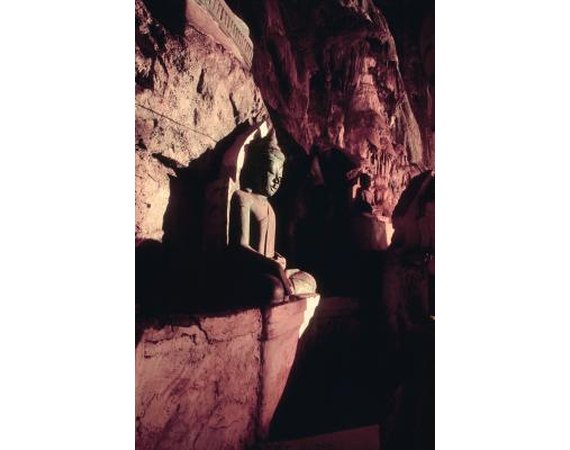
Dim lighting can be a photographers bane, hiding the details of the composition in shadows and making it difficult to capture a well-exposed, sharp photograph of the subject. Of course, the obvious solution is to use the cameras flash or an external light source to illuminate the scene. If that option is unavailable, there are other techniques that help with dimly lit photographic compositions.
Instructions
- 1
Use the on-camera flash or another light source, such as a slave flash or strobe light. To use an external light source without introducing harsh shadows and lighting into the composition, aim the light off of the ceiling to use it as a bounce flash, or shoot through a light diffuser. If space allows, you can also bounce the light off a light umbrella.
2Shoot in RAW mode, if your camera supports it. RAW files allow you to make white balance and exposure level changes in post-production without degrading the quality of the image.
3Use a bigger aperture. A smaller aperture number opens up the lens, allowing more light to be recorded by the image sensor. A small aperture value trades low-light performance for a shallower depth of field.
4Use a slower shutter speed. If your lens or camera has it available, turn on image stabilization or vibration reduction mode. If the shutter speed is too slow to shoot hand-held, set the camera on a flat, stable surface or use a tripod, if space and time constraints allow.
5Bump up the ISO. A higher ISO value allows you to shoot with a faster shutter speed, though it may introduce noise into the image, especially in dark areas of the composition.
6Use a faster lens, such as a fixed prime lens with a large maximum aperture size. Prime lenses typically have a much larger maximum aperture, making them ideal for low-light situations.

Dim lighting can be a photographers bane, hiding the details of the composition in shadows and making it difficult to capture a well-exposed, sharp photograph of the subject. Of course, the obvious solution is to use the cameras flash or an external light source to illuminate the scene. If that option is unavailable, there are other techniques that help with dimly lit photographic compositions.
Instructions
- 1
Use the on-camera flash or another light source, such as a slave flash or strobe light. To use an external light source without introducing harsh shadows and lighting into the composition, aim the light off of the ceiling to use it as a bounce flash, or shoot through a light diffuser. If space allows, you can also bounce the light off a light umbrella.
2Shoot in RAW mode, if your camera supports it. RAW files allow you to make white balance and exposure level changes in post-production without degrading the quality of the image.
3Use a bigger aperture. A smaller aperture number opens up the lens, allowing more light to be recorded by the image sensor. A small aperture value trades low-light performance for a shallower depth of field.
4Use a slower shutter speed. If your lens or camera has it available, turn on image stabilization or vibration reduction mode. If the shutter speed is too slow to shoot hand-held, set the camera on a flat, stable surface or use a tripod, if space and time constraints allow.
5Bump up the ISO. A higher ISO value allows you to shoot with a faster shutter speed, though it may introduce noise into the image, especially in dark areas of the composition.
6Use a faster lens, such as a fixed prime lens with a large maximum aperture size. Prime lenses typically have a much larger maximum aperture, making them ideal for low-light situations.
io9 - We come from the future.
io9.comWe come from the future. ... Are you a fan of Doctor Who and/or alcohol poisoning? Then The Warp Zone's Doctor Who drinking game is for you!
Wonder How To Show & Tell for Creators & Doers
www.wonderhowto.comWonder How To is your guide to free how to videos on the Web. Search, Browse and Discover the best how to videos across the web using the largest how to video index ...
Photo Radar Scam - Info on How to Beat Your Photo Radar or
photoradarscam.com/getout.phpDefense Strategies, Information to beat Red Light Camera and Photo Radar Cameras Tickets and Citations in Court
Strobist
www.strobist.blogspot.com
The world's most popular free resource for learning how to use off-camera flash.
Flickr: Help: Photos - Welcome to Flickr - Photo Sharing
www.flickr.com/help/photosHow do I upload my photos? The easiest way to upload to Flickr is to use our Web Uploadr. For quick access we have added an "Upload" link to the navigation at the top ...
How to Lose Neck Fat How To Get Rid Of A Double Chin
howtogetridofadoublechin.org/how-to-lose-neck-fatHow to Lose Neck Fat. Want to Lose Neck Fat? My Favorite Way is a Neck Slimming Device that Costs Under $15 and It Works! Read on to Learn More or Click Here and Get ...
The Rules Revisited: How To Look Good During Sex
www.therulesrevisited.com/2011/08/how-to-look-good-during-sex.htmlI've dated countless women and it has always amazed me how little they know about men. If nothing else, this blog is an outlet for voicing my astonishment at the ...
Don's light, lamp and strobe site!
donklipstein.comDon Klipstein's Web Site! Quick Index: LEDs in General Bright and Efficient LEDs Lighting Top Page Incandescant and Halogen Lamps Fluorescent Lamps
This comment has been removed by the author.
ReplyDelete